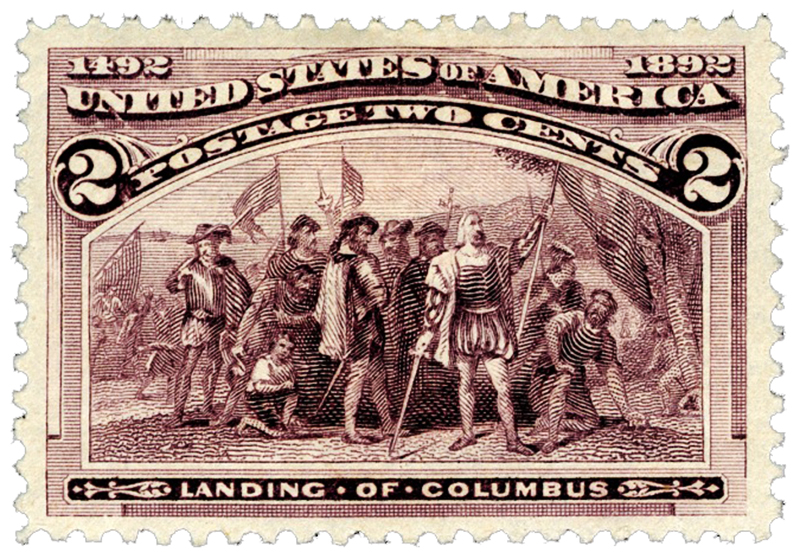Commemorative stamps are made to honor a certain person, place, or event. Commemorative postage stamps are also printed to highlight and promote national or international events.
These commems or special issue stamps are either circulated together with the regular postage stamps or the postal service may use the commemorative postage stamps as compulsory issues.
But ironically, the advent of the first American commemorative stamp was not very well accepted. The controversial Columbian Exposition postage stamp issued in 1893 was severely criticized and deemed “useless” by the US Congress.
The Columbian stamps commemorated the World Columbian Exposition held in Chicago in the same year these postage stamps were introduced. But even if the critics hated them, the philatelist equally loved them!
As the Columbian stamps gained a huge following from the public, the stamp’s issuer John Wanamaker saw this as a business opportunity. His optimism proved him right as commemorative postage stamps have become a philatelic favorite all around the world. Today, almost all national postal service worldwide have special issues of commemorative stamps.
Early commemorative stamps all around the world

In July 1887, the local German post office Privat Brief Verkehr in Frankfurt-am-Main released German postage stamps honoring the Ninth German Federal and Jubilee shooting contest. The year after, several commemorative stamps were issued to mark the deaths of two German Emperors.
In the spring of 1888, New South Wales observed the occasion of the colony’s 100th year anniversary. This event was memorialized with a commemorative stamp series that remained in circulation for 12 years.
Other postal offices followed suit and commemorative stamps were printed in distant parts of the globe. Hong Kong made special postal stamps when they celebrated their 50th colonial anniversary in 1891. Countries El Salvador and Nicaragua jointly issued commemorative stamp sets in 1892 to celebrate the 400th anniversary of Christopher Columbus’ discovery of America.
Commemorative postage stamps did not appear in Europe until 1893 when Montenegro made overprints on a special stamp issue to mark its 25th anniversary of printing.
Millions of commemorative stamps have been issued all over the world. Big events and anniversaries have become great opportunities for commemorative stamp programs. Best of all, commemorative stamp sets are always sensational among philatelists eager to collect the latest releases.
Special issue stamps
There are non-commemorative stamps that are printed out of the regular issues. They are often called special issues and they include any stamp series with a limited production time. Like the commemorative stamps, special issue stamps are thematic in nature.
Special issue stamps cover almost all events known such as Mother’s Day, Christmas, Easter, baby showers, and many more. Often times, these are greeting stamps that carry messages from “get well soon” to “I love you”.
Other uses of commemorative stamps and special issue postage stamps
Propaganda stamps
More than its celebratory purposes, commemorative postage stamps can be employed for political campaigns. These are called propaganda stamps. A good example is a 1982 postage stamp issued in Venezuela.
The country wanted to relinquish their territorial rights over British Guiana. Thus, Venezuelan government printed postage stamps that featured their contested territory.
Propaganda stamps became one of the vehicles for national solidarity in communist nations. German propaganda stamps and USSR stamps were a hit during the communist eras. Even Vietnam issued propaganda stamps in the 1970s to counter American aggression.
Charity stamps and welfare stamps
Postage stamps can also be a medium in supporting good causes. A charity stamp or what Americans call a semi-postal, has a premium (mark up price that goes to the charitable institution) added to the basic charge of the postal service.
Even if commemorative stamps came later in Europe, it was in Great Britain that the idea for charity stamps was first conceived in 1890. The first charity stamps raised money for the Rowland Hill Benevolent Fund for Post Office Widows and Orphans.
Charity stamps and semi-postals are still issued today for various local and international charities. However, some stamps for charity carry very high premiums.
The concept behind the charity stamps was adopted by other causes and it paved the way for welfare stamps. Social welfare stamps are printed in almost every country. They are called youth stamps or “Jugendmarke” in Germany. While Netherlands make postage stamps marked with “Voor het kind” (for the child), and its proceeds will go to various children’s health camps.
For some time, Yugoslavia along with Portugal issued compulsory charity tax stamps. Since these postage stamps have been made de rigueur by their respective governments, mails that do not carry such stamps are surcharged.
Commemorative stamp collecting and commemorative stamp values
Philatelists flock to the first day of issue ceremonies where commems are displayed for the public. This event is usually held at a location connected with the stamp’s subject. Complete commemorative stamp albums can be purchased, too, from philately shops. A full sheet of first day issue commems, just like other stamps in their initial release, is wrapped in plastic.
Commemorative stamps are usually for sale for one year after their issue ceremonies. Most commems are available through the USPS. Commemorative stamp values are above the price of its face value since commems are issued for a limited time.
A commemorative postage stamp may also be issued as a “mint stamp”, meaning it has not been sold as a used issue and it has not been cancelled. Mint commemorative stamps have higher values.
Millions of interesting commemorative stamp designs has been issued that some advanced philatelists may use a stamp catalog software to arrange their extensive commemorative stamp collection.










Leave a Reply